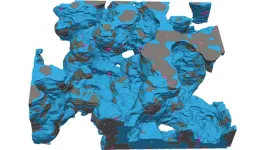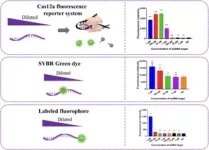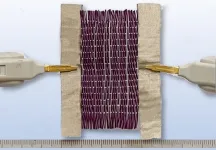(Press-News.org) Proton-exchange membrane fuel cells (PEMFC), which are being developed for use in electric vehicles, rely on nanoparticles called catalysts to trigger electricity-producing reactions between hydrogen and oxygen. Most PEMFC catalysts contain platinum – a scarce and precious metal. There is therefore a pressing global need to develop catalysts that can generate the most power while minimizing platinum content.
Manufacturers integrate these catalysts in complex assemblies called catalyst layers. Until now, they had to do so without a detailed picture of the resulting structure, as traditional imaging processes almost always cause some degree of damage. Vasiliki Tileli, head of the Laboratory for in-situ nanomaterials characterization with electrons in the School of Engineering, has found a way around this challenge. By imaging catalysts and their environment at below-freezing temperatures using cryogenic transmission electron tomography and processing the images with deep learning, she and her colleagues have succeeded in revealing, for the first time, the nanoscale structure of catalyst layers.
“We’re still far away from PEMFCs without platinum, which is very expensive, so in the short term, we need to reduce platinum loading to make this technology viable for mass production. It’s therefore imperative to understand how platinum sits in relation to other materials within the catalyst layer, to increase the surface area contact required for chemical reactions to take place,” Tileli explains.
“That’s why it’s quite an achievement to image these catalysts in three dimensions; before, it was impossible to have the right contrast between the different catalyst layer components.” The work has recently been published in the journal Nature Catalysis.
Better preservation; higher resolution
During imaging using conventional electron microscopy, delicate catalyst layer samples often become damaged by electron beams, causing materials to shrink or deform. By carrying out the imaging in-situ at cryo-temperatures, Tileli and her team were able to preserve most of the catalyst layer’s morphology. Then, they used a machine learning algorithm to more accurately denoise and classify the images, allowing them to achieve a higher image resolution than had ever previously been possible.
Crucially, the scientists were able to reveal the heterogenous thickness of a porous polymer layer on the catalysts called ionomer. Ionomer thickness strongly influences how well platinum catalysts perform.
“The ionomer must have a certain thickness for the catalytic reactions to happen efficiently. Because we could do a full reconstruction of catalyst layers with limited damage to the structure, we could show, for the first time, how much platinum is covered with ionomer and the thickness of that coverage,” Tileli explains.
Such information could be a gold mine for catalyst manufacturers, who could use it to produce catalysts with more platinum particles that are covered by the right amount of ionomer – and that therefore perform optimally.
“The cryo-aspect is the key component of this study. Ionomers are like proteins: they are soft, and require freezing conditions to stabilize and protect their structure,” Tileli says.
“I think this advanced technique will therefore be useful not just for facilitating the mass manufacturing of PEMFCs through optimized platinum use, but also for many different materials science and energy applications – for example, battery storage, water electrolysis, and energy conversion systems in general.”
END
Cryo-imaging lifts the lid on fuel cell catalyst layers
Thanks to a novel combination of cryogenic transmission electron tomography and deep learning, EPFL researchers have provided a first look at the nanostructure of platinum catalyst layers, revealing how they could be optimized for fuel cell efficiency.
2023-04-24
ELSE PRESS RELEASES FROM THIS DATE:
Study finds significant variation in anatomy of human guts
2023-04-24
New research finds there is significant variation in the anatomy of the human digestive system, with pronounced differences possible between healthy individuals. The finding has implications for understanding the role that the digestive tract’s anatomy can play in affecting human health, as well as providing potential insights into medical diagnoses and the microbial ecosystem of the gut.
“There was research more than a century ago that found variability in the relative lengths of human intestines, but this area has largely been ignored since then,” says Amanda Hale, co-first author of the study and a Ph.D. ...
As “deprescribing” medicines for older adults catches on, poll shows need for patient-provider dialogue
2023-04-24
As the movement toward “deprescribing” medications among older adults grows, a new poll shows strong interest in this idea.
A full 80% of adults aged 50 to 80 would be open to stopping one or more of the prescription medicines they’ve been taking for more than a year, if a health care provider said it was possible. Already, 26% said they have done so in the past two years.
Of those willing to stop a medicine, 67% said they would likely ask for advice about doing so at their next visit with a provider, according to the new ...
If it pays to be a jerk, why isn’t everyone that way?
2023-04-24
DURHAM, N.C. -- Throw a tantrum. Threaten, shove aside or steal from your colleagues. Science confirms, yet again, that brutish behavior can be an effective path to power. And not just in humans, but in chimpanzees, too.
A new study appearing April 24 in the journal PeerJ Life and Environment found that male chimps with more bullying, greedy and irritable personalities reached higher rungs of the social ladder and were more successful at siring offspring than their more deferential and conscientious counterparts.
But if that’s the case, researchers ask, why isn’t every chimp a bully?
A team led by researchers at the ...
New neurosurgery research: Surgical versus nonsurgical treatment of pituitary apoplexy
2023-04-24
The first prospective study comparing outcomes in patients with pituitary apoplexy—sudden bleeding or death of a pituitary tumor—found that patients managed medically fared as well as those treated surgically in the majority of cases. The multicenter international study, led by Cedars-Sinai investigators, was presented today at the American Association of Neurological Surgeons Scientific Meeting in Los Angeles.
“This is the best data to date on the question of surgery versus medical management in patients with this rare but serious condition,” said Adam Mamelak, MD, co-director ...
AAAS announces winners of the inaugural Mani L. Bhaumik Breakthrough of the Year Award
2023-04-24
The American Association for the Advancement of Science’s (AAAS) inaugural Mani L. Bhaumik Breakthrough of the Year Award — focused on standout contributors to NASA’s James Webb Space Telescope (JWST) — honors three individuals who supported vast swaths of the JWST community over decades and whose persistence amid multiple setbacks ensured the mission’s completion.
The award recognizes Major General Charles Frank Bolden Jr., USMC (Ret), a former administrator of the National Aeronautics and Space Administration (NASA); John Mather, senior project scientist of the JWST since 1995; and Bill Ochs, JWST project manager from 2011 through the telescope’s ...
Do vitamin D levels affect the body’s response to anti-cancer immunotherapy?
2023-04-24
Study’s findings suggest that maintaining normal vitamin D levels may benefit patients.
New research indicates that for patients with advanced skin cancer, it may be important to maintain normal vitamin D levels when receiving immunotherapy medications called immune checkpoint inhibitors. The findings are published by Wiley online in CANCER, a peer-reviewed journal of the American Cancer Society.
Vitamin D has many effects on the body, including regulation of the immune system. To see whether levels of vitamin D might impact the effectiveness of immune checkpoint inhibitors, investigators analyzed the blood of 200 patients with advanced melanoma both before and every 12 weeks ...
Drug combination restores ability of leading treatment to signal for death of blood cancer cells
2023-04-24
Despite the promise of new medications that promote cancer cell death in people with acute myeloid leukemia, leukemic cells often adopt features that let them evade the drugs’ effects within a year.
Now, new research using human tissue samples and mouse models has found that resistance of leukemia cells to a widely prescribed drug called venetoclax occurs because of a rapid increase in the breakdown and turnover of mitochondria, structures inside the cell that help power its functions. In addition to their role in producing energy, mitochondria also tell cells to die under certain adverse conditions.
This process of “programmed cell ...
Increased risk of testicular cancer in people with neurodevelopmental disorders
2023-04-24
A new study by researchers at Uppsala University and Uppsala University Hospital shows that men who have a neurodevelopmental disorder, such as autism and ADHD, also have a slightly increased risk of testicular cancer, or seminoma. This is the first study to show such a link, with the results to be published in the British Journal of Cancer.
Testicular cancer is the most common form of cancer in young men, and its underlying causes are still largely unknown.
“As testicular cancer can be surgically removed, thus curing the disease, it is important to seek care in time if you feel a lump in your testicle,” notes Ingrid ...
Single CT scan in kids low risk for cancers, but 4 or more CTs increases risk
2023-04-24
For children under age 18 years, a single computed tomography (CT) scan is not associated with an increased risk of brain tumours, leukemia or lymphoma, but exposure to 4 or more scans before adulthood more than doubles the risk, according to new research https://www.cmaj.ca/lookup/doi/10.1503/cmaj.221303 in CMAJ (Canadian Medical Association Journal).
Computed tomography in children has increased worldwide in recent decades, but there is conflicting evidence about the risks of cancer from these ...
New programmable smart fabric responds to temperature and electricity
2023-04-24
A new smart material developed by researchers at the University of Waterloo is activated by both heat and electricity, making it the first ever to respond to two different stimuli.
The unique design paves the way for a wide variety of potential applications, including clothing that warms up while you walk from the car to the office in winter and vehicle bumpers that return to their original shape after a collision.
Inexpensively made with polymer nano-composite fibres from recycled plastic, the programmable fabric can change its colour and shape when stimuli are applied.
“As a wearable material alone, it has almost infinite potential ...
LAST 30 PRESS RELEASES:
Interaction of climate change and human activity and its impact on plant diversity in Qinghai-Tibet plateau
From addressing uncertainty to national strategy: an interpretation of Professor Lim Siong Guan’s views
Clinical trials on AI language model use in digestive healthcare
Scientists improve robotic visual–inertial trajectory localization accuracy using cross-modal interaction and selection techniques
Correlation between cancer cachexia and immune-related adverse events in HCC
Human adipose tissue: a new source for functional organoids
Metro lines double as freight highways during off-peak hours, Beijing study shows
Biomedical functions and applications of nanomaterials in tumor diagnosis and treatment: perspectives from ophthalmic oncology
3D imaging unveils how passivation improves perovskite solar cell performance
Enriching framework Al sites in 8-membered rings of Cu-SSZ-39 zeolite to enhance low-temperature ammonia selective catalytic reduction performance
AI-powered RNA drug development: a new frontier in therapeutics
Decoupling the HOR enhancement on PtRu: Dynamically matching interfacial water to reaction coordinates
Sulfur isn’t poisonous when it synergistically acts with phosphine in olefins hydroformylation
URI researchers uncover molecular mechanisms behind speciation in corals
Chitin based carbon aerogel offers a cleaner way to store thermal energy
Tracing hidden sources of nitrate pollution in rapidly changing rural urban landscapes
Viruses on plastic pollution may quietly accelerate the spread of antibiotic resistance
Three UH Rainbow Babies & Children’s faculty elected to prestigious American Pediatric Society
Tunnel resilience models unveiled to aid post-earthquake recovery
Satellite communication systems: the future of 5G/6G connectivity
Space computing power networks: a new frontier for satellite technologies
Experiments advance potential of protein that makes hydrogen sulfide as a therapeutic target for Alzheimer’s disease
Examining private equity’s role in fertility care
Current Molecular Pharmacology achieves a landmark: real-time CiteScore advances to 7.2
Skeletal muscle epigenetic clocks developed using postmortem tissue from an Asian population
Estimating unemployment rates with social media data
Climate policies can backfire by eroding “green” values, study finds
Too much screen time too soon? A*STAR study links infant screen exposure to brain changes and teen anxiety
Global psychiatry mourns Professor Dan Stein, visionary who transformed mental health science across Africa and beyond
KIST develops eco-friendly palladium recovery technology to safeguard resource security
[Press-News.org] Cryo-imaging lifts the lid on fuel cell catalyst layersThanks to a novel combination of cryogenic transmission electron tomography and deep learning, EPFL researchers have provided a first look at the nanostructure of platinum catalyst layers, revealing how they could be optimized for fuel cell efficiency.






